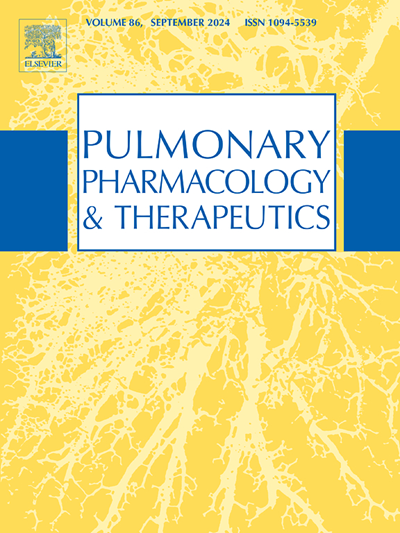Effect of EP395, a novel anti-inflammatory macrolide, in an inhaled lipopolysaccharide challenge model in healthy volunteers: a randomised controlled trial
IF 2.8
3区 医学
Q2 PHARMACOLOGY & PHARMACY
引用次数: 0
Abstract
EP395, a macrolide with negligible antimicrobial activity but with anti-inflammatory effects in murine lipopolysaccharide (LPS) challenge model, is being developed as a potential treatment to reduce COPD exacerbations. This double-blind, placebo-controlled clinical study evaluated the pharmacodynamics of EP395 in response to inhaled LPS, an established clinical model for assessing anti-inflammatory effects of potential new treatments.
Forty-nine healthy, non-smoking participants were randomised to oral 375 mg EP395 or placebo, daily for 3 weeks. An inhaled LPS challenge (2 μg) was then given, followed 6 h later by bronchoscopy for bronchoalveolar lavage fluid (BALF) collection. Blood samples were collected pre, 6 and 24 h after LPS challenge.
BALF concentrations of IL-6, TNF-α, MIP-1α, MIP-1β and MCP-1 were lower with EP395 than placebo, while IL-33, IL-8, and IL-1β were higher with EP395 than placebo (not statistically significant). Neutrophil counts were unaffected, but neutrophil elastase and myeloperoxidase were higher with EP395 than placebo (not statistically significant). Serum concentrations of surfactant protein-D significantly increased in the EP395 group in response to LPS at both 6 and 24 h compared with pre-LPS (mean pre-LPS 148.8 ng/mL; mean 24 h post-LPS 183.0 ng/mL) but not in the placebo group (mean pre-LPS 142.4 ng/mL; mean 24 h post-LPS 142.4 ng/mL). The log2 transformed fold difference in the EP395 group, before and 24 h after LPS challenge was 0.33 (95 % CI 0.52, 0.14; p = 0.0007).
EP395 treatment increased the host defence response to inhaled LPS, including the epithelial response, whilst reducing inflammatory site pro-inflammatory mediators.
新型抗炎大环内酯EP395在健康志愿者吸入脂多糖刺激模型中的作用:一项随机对照试验
EP395是一种大环内酯类药物,抗菌活性可忽略不计,但在小鼠脂多糖(LPS)挑战模型中具有抗炎作用,目前正被开发为一种减少COPD恶化的潜在治疗方法。这项双盲、安慰剂对照的临床研究评估了EP395对吸入LPS的药效学反应,这是一种评估潜在新疗法抗炎作用的临床模型。49名健康、不吸烟的参与者被随机分组,每天口服375毫克EP395或安慰剂,持续3周。然后给予吸入LPS (2 μg), 6小时后进行支气管镜检查收集支气管肺泡灌洗液(BALF)。在LPS刺激前、6和24小时采集血样。EP395组IL-6、TNF-α、MIP-1α、MIP-1β、MCP-1的BALF浓度低于安慰剂组,IL-33、IL-8、IL-1β浓度高于安慰剂组(差异无统计学意义)。中性粒细胞计数未受影响,但EP395组中性粒细胞弹性酶和髓过氧化物酶高于安慰剂组(无统计学意义)。与LPS处理前相比,EP395组在LPS处理后6和24小时血清表面活性剂蛋白d浓度均显著升高(LPS处理前平均148.8 ng/mL;lps后平均24小时183.0 ng/mL),但安慰剂组没有(lps前平均142.4 ng/mL;lps后平均24 h 142.4 ng/mL)。LPS刺激前和24小时后,EP395组的log2转化倍数差异为0.33 (95% CI 0.52, 0.14;p = 0.0007)。EP395处理增加了宿主对吸入LPS的防御反应,包括上皮反应,同时减少了炎症部位的促炎介质。
本文章由计算机程序翻译,如有差异,请以英文原文为准。
求助全文
约1分钟内获得全文
求助全文
来源期刊
CiteScore
6.20
自引率
0.00%
发文量
41
审稿时长
42 days
期刊介绍:
Pulmonary Pharmacology and Therapeutics (formerly Pulmonary Pharmacology) is concerned with lung pharmacology from molecular to clinical aspects. The subject matter encompasses the major diseases of the lung including asthma, cystic fibrosis, pulmonary circulation, ARDS, carcinoma, bronchitis, emphysema and drug delivery. Laboratory and clinical research on man and animals will be considered including studies related to chemotherapy of cancer, tuberculosis and infection. In addition to original research papers the journal will include review articles and book reviews.
Research Areas Include:
• All major diseases of the lung
• Physiology
• Pathology
• Drug delivery
• Metabolism
• Pulmonary Toxicology.

 求助内容:
求助内容: 应助结果提醒方式:
应助结果提醒方式:


